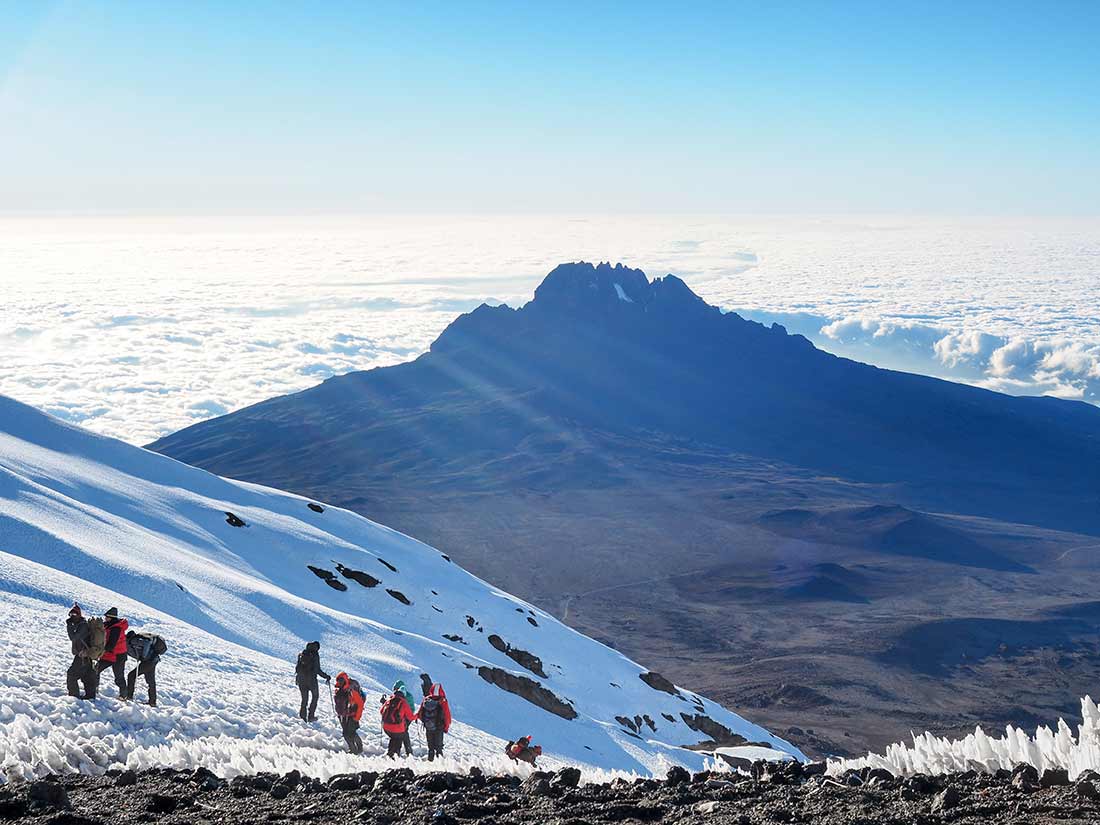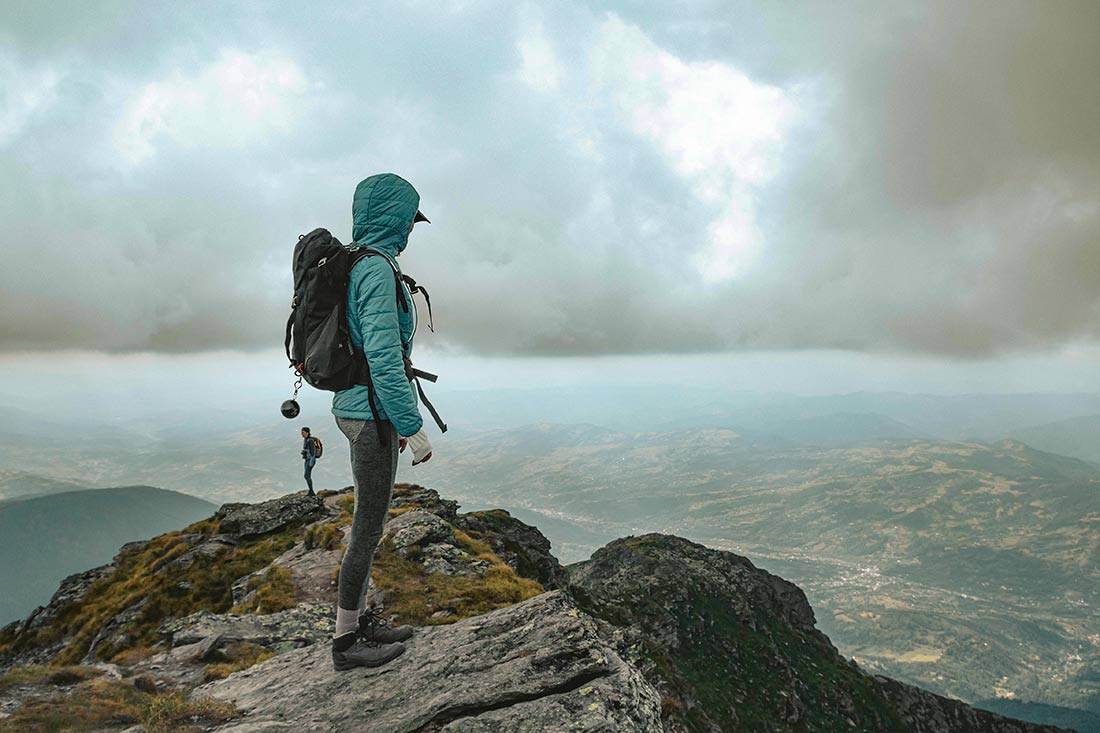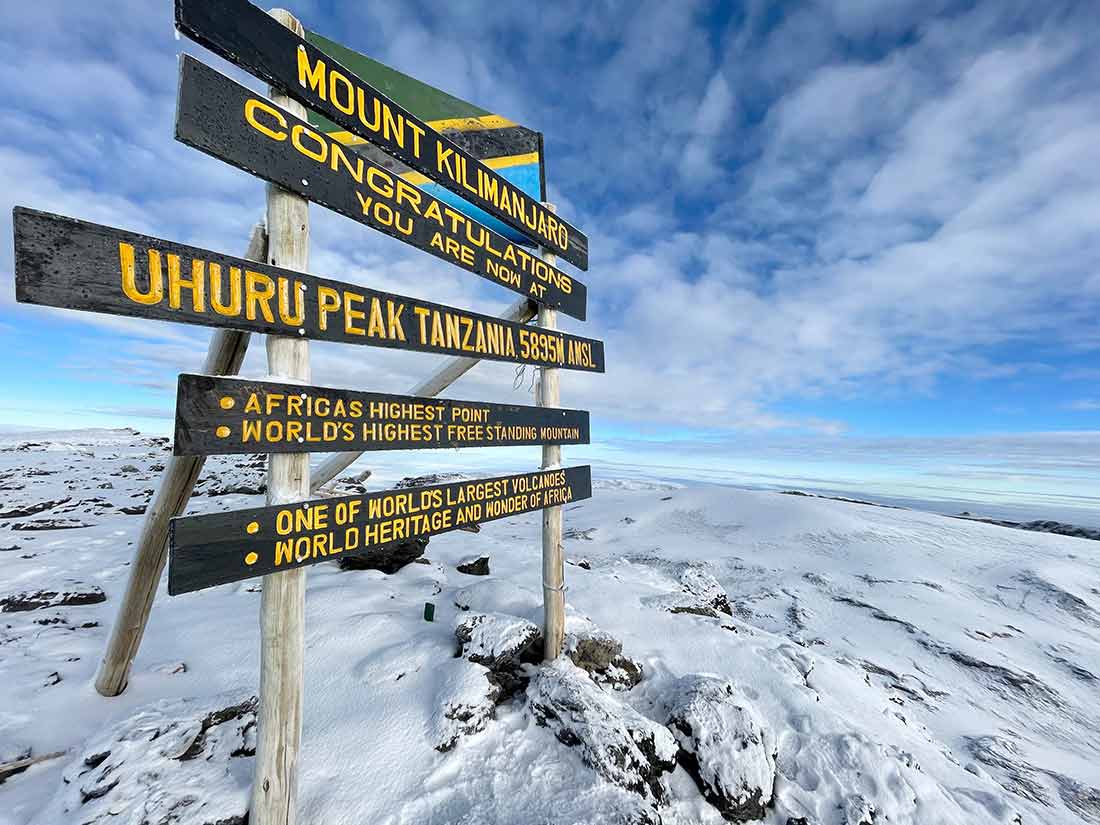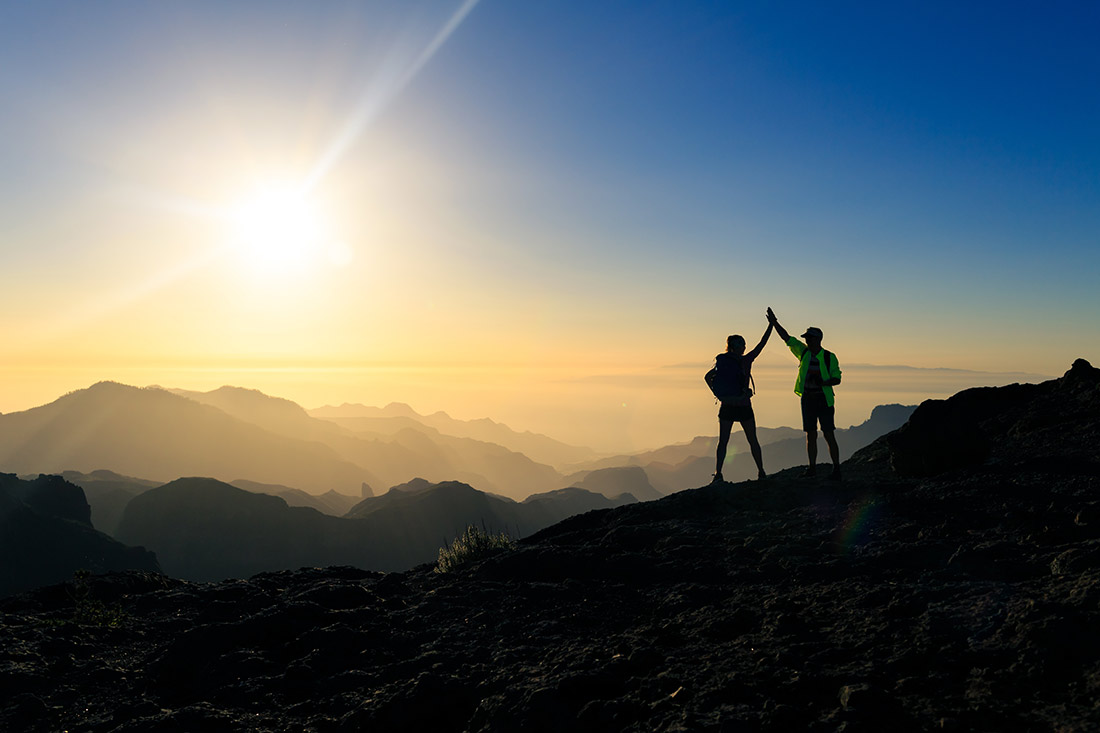Clients and potential clients email and call us all the time before booking their Kilimanjaro climb. Some find that the trip itself is too intimidating and switch their plans, others get excited about the challenge and book right away, and some meticulously plan every step before booking their trip. Whichever category you fall into, here are the top seven questions everyone asks before climbing Kilimanjaro.
1). How difficult is it to climb Mount Kilimanjaro?
The first and most important thing to know about climbing Kilimanjaro is that you actually do not climb at all. All the routes are walkable to the summit. That means you do not need any climbing equipment such as ropes, helmets, and harnesses. It requires no mountaineering skills. All routes are on well-groomed trails.
For example, the most popular route on Kilimanjaro is the Machame Route. It is 39 miles (depending on where you camp, some sites like Barranco Valley are quite large) from the gate to the summit and back to the gate. We offer it as a seven-day climb. That means you are doing approximately 5.5 miles a day. The eight-day Lemosho is 46 miles, which is about 5.75 miles a day. You can see more here: https://kilimanjarosunrise.com/kilimanjaro-routes/
2). Why do so many people not make the summit?
The answer above makes it seem like hiking Kilimanjaro is easy. But it is not. First of all, many people have not been hiking for more than one to two days. Our routes start at six (Rongai) and go up to nine (Northern Circuit) days. This is mentally challenging.
Furthermore, many people are also not used to roughing it. Bathing with a warm bowl of water and wipes, sleeping in a tent, being cold, and walking for so many days is more than they can bear. They give up.
But the number one reason fail to make the summit is the elevation. Our guides make sure you hike extremely slowly. We also practice the climb high sleep lower method of acclimating. This means we hike up to an elevation—like Lava Tower at 15,100 feet, but descend to Barranco Valley at 12,800 feet to camp for the night.
The elevation means there is less oxygen and that is what causes most people to fail to reach the summit. Want to know how to prepare for that? Go here: https://kilimanjarosunrise.com/ways-to-prevent-altitude-sickness-on-kilimanjaro/
This lack of oxygen causes altitude sickness and is the leading cause of people failing to reach the summit.
3). How can I increase my summit success rate?
It is only logical that if you manage to avoid altitude sickness, you’ll stand a much better chance of getting to Uhuru Peak. So how do you prepare for it? Start with reading the information we provide for you. Our website has tons of information regarding your Kilimanjaro climb. The emails we send you also are informative. Once you make your deposit we even send you a guidebook that has pages of packing, training, and preparation information.
Choosing the right route for you to the summit is also important. If you are an experienced trekker then a shorter route like Rongai or Machame will probably be good for you. If you are new to trekking then the Lemosho or Northern Circuits would be better since they are longer and allow your body more time to acclimate. Of course, the Rongai route is also the easiest since it is more gradual, but you are only on the mountain for six days so that can affect your ability to acclimate.
Prepare Reading our website and the guidebook is also very helpful when it comes to acquiring the right gear. The mountain has five distinct climate zones and you need to prepare with clothes for the hot and humid rainforest to the frigid, windy summit.
Clothing Read more here about what clothes to bring for your trip: https://kilimanjarosunrise.com/the-complete-list-of-items-to-bring-for-kilimanjaro/
Footwear Proper footwear is also important. You can watch a video here: https://www.youtube.com/watch?v=AI4KTKoHAgk
Train Proper training is another factor when successfully making the summit. If you are in really good shape, your body doesn’t have to work as hard and in turn, allows your body to acclimate better.
Here is what we recommend for training: https://kilimanjarosunrise.com/kilimanjaro-training-program/
Drink While you are on the mountain it can be difficult to keep drinking water, especially when you are cold. But you need to stay hydrated. The guides will tell you to drink—”Maji, Maji”—which is Swahili for drink, drink. Read more here: https://kilimanjarosunrise.com/how-to-stay-hydrated-while-climbing-kilimanjaro/
Eat You also need to eat. We provide plenty of warm, delicious food for your climb. Eat as much as you can. You need the calories to continue fueling your body as you ascend. Don’t worry, we have plenty of food and even get resupplied part way up the mountain.
Following all this advice will definitely increase your summit success rate.
4). What’s the best route on Kilimanjaro?
Whether it is your first time trekking or you’ve climbed many peaks, there are several Kilimanjaro routes. Selecting the appropriate route for you will maximize your enjoyment and chance of success. Keep in mind, we will be with you every step of the way.
There are six main climbing routes on Kilimanjaro. The Machame, Lemosho, Northern Circuit, Rongai, Marangu, Umbwe, and Shira. Wait that is seven? That is because the Umbwe is not used as a climbing route. It is mainly used as a resupply route.
Of these six routes, we offer only four as group climbs due to their success rates and overall they are better routes. They are:
We do not offer the Shira Route since you drive above the Rainforest and it starts above 11,000 feet. This doesn’t allow your body enough time to acclimate. We also do not offer the Marangu route as a group climb since it is the only route that goes up and down on the same trail making it quite crowded. We do offer it as a private climb and recommend it during the rainy season (November and Mid-March to the end of May) since it is the only route that has clients sleeping in huts instead of tents.
Which route should you choose? We recommend either the Lemosho or Northern Circuits to increase your summit success chances. Also, we feel the Lemosho is the prettiest of all the routes.
| ROUTE | MILES | DESCRIPTION |
|---|---|---|
| DAYS | ||
| Lemosho (Recommended) |
46 | The Lemosho route is considered the most beautiful on Kilimanjaro. It begins on the west side of Kilimanjaro and climbs to the Shira Plateau before circling counter-clockwise and approaching the Summit from the southeast. |
| 8 | ||
| Northern Circuit (Recommended) |
54 | The Northern Circuit Route also starts from the west, this is the only route that circles clockwise around the northside before approaching the summit from the northeast. |
| 9 | ||
| Rongai (Recommended) |
43 | The Rongai route begins in the remote northern side of Kilimanjaro near the Kenyan border. It ascends towards the jagged Mawenzi Peak, crosses the saddle, and approaches the Summit via the eastern side |
| 6 | ||
| Machame | 39 | The Machame Route is also known as the “Whiskey” route. It begins from the south ascending the Shira Plateau. Machame then joins the Lemosho route and summits from the southeast. |
| 7 |
5). When should I climb Kilimanjaro?
Kilimanjaro National Park is open every day of the year. However, as we mentioned before there are two rainy seasons mid-March through the end of May (Long Rainy Season) and November (Short Rainy Season). Very few people climb Kilimanjaro during these seasons.
The main trekking seasons fall during the dry seasons. Which are mid-December through mid-March and June through October.
However, that doesn’t mean it won’t rain on you. Kilimanjaro’s base is surrounded by rainforest and you both ascend and descend through it. You can read more about the mountain climate zones here: https://kilimanjarosunrise.com/the-climate-zones-of-kilimanjaro/
When do we recommend climbing?
We like trekking at any time on Kilimanjaro. But if you want us to narrow it down. September and October are our favorite months. The summer crowds have died down and the weather is still fairly mild. The end of February until mid-March is also another great time to climb. The holiday crowds are already off the mountain by then.
Read more here: https://kilimanjarosunrise.com/when-to-climb-kilimanjaro/
6). How much does it cost to climb Mount Kilimanjaro?
The cheapest, riskiest, and overall most dangerous way to climb Kilimanjaro is to fly to Tanzania and try to find a company to climb with once you are there. They can take you onto the mountain for about $1,500. But this rarely turns out okay. First of all, they may just take your money and run. They almost always do not care if you make the summit and thirdly, they will not make sure you are properly equipped and definitely do not perform daily health checks. We highly recommend avoiding this plan of action at all costs.
Budget Operators
A step above this method is the budget operators. Again, they are not there to make sure you summit, they are there to take your money. They usually charge around $2,000 per person. Sure, if you are an experienced trekker you may make the summit. Not only is that dangerous, but we are pretty sure they don’t care about your or the porters’ welfare. Budget operators are the reason Kilimanjaro Porter Assistance Project (KPAP) was created. Many budget companies choose to make money versus caring for their porters. They do not clothe them properly, they overload them, and many don’t feed them more than once a day.
KPAP makes sure that the porters are fed three meals, have the proper equipment to ascend the mountain, and only carry a maximum of 33 pounds (15 kgs).
Mid-Range Companies
Mid Range operators are just that, they fall between the Budget and the Luxury Operators. Kilimanjaro Sunrise is a Mid-Range Operator. This means we offer about the same service as the Luxury operators, but our guides and porters do not have matching uniforms. Our tents do not have our logos embroidered on them and we don’t pay a lot of money for marketing and advertising. Conversely, we do offer daily health checks, are members of KPAP, and take meticulous care of our equipment. Additionally, we offer rental equipment and provide three hot meals a day. We have a 1 to 2 guide-to-client ratio and on summit night we also bring our senior porters along to the summit. This means you’ll never be alone on the mountain. Your safety is our number one priority.
Luxury Operators
Luxury Operators offer almost the same level of service as Mid-Range operators. But like we said, they have better marketing and advertising, and all their clothes, tents, and flags match their brand. Their services generally run about $5,000 per person.
7). What is included in the climb price?
Included in this price should be the following:
- The night before and after your climb in a hotel.
- Transport to and from the mountain at the start/end of the trek
- All park fees, rescue fees, conservation fees, and camping fees
- Food and drink on the mountain, as well as camping equipment
- Wages of your guides, assistant guides, cook, and porters
- Oxygen on the mountain should also be issued as standard.
These items are, typically, not included in your trek package so you’ll need to budget for them:
- Airfares
- Tips
- Tanzanian visas ($50 USD for most people, $100 USD for American passport holders)
- Meals when you’re not on the mountain (other than breakfast).
- Travel Insurance
- Souvenirs
Final thoughts
These are just the top seven questions everyone asks before climbing Kilimanjaro. We are sure you’ll have plenty more questions before our Kilimanjaro climb. I know we did the first time. If your question wasn’t listed here, you can go to our Frequently Asked Questions (FAQs) page here: https://kilimanjarosunrise.com/kilimanjaro-faqs/
It is good to ask questions. The more you ask the better prepared you’ll be to successfully summit Kilimanjaro. Keep in mind that choosing the right operator is the most important decision you can make to have a safe Kilimanjaro climb.







